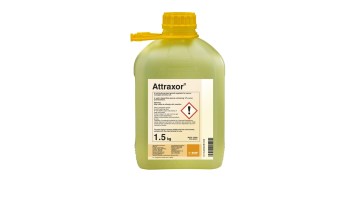Crowborough Beacon Golf Club: Using Attraxor to control Poa annua seeding
27.01.2023
• Grass quality on greens improved tenfold
• Significant decrease in seed heads
• Attraxor playing a huge part in the transition of grass species on greens
A Sussex golf club have explained the advantages of using Attraxor to control Poa Annua and improve grass quality.
James Bass, Deputy Course Manager based at Crowborough Beacon Golf Club in East Sussex explains that he has been actively using Attraxor for 18 months and that the course spray Attraxor monthly along with a biological feed programme on the greens.
Founded in 1895, the dramatic heathland setting of Crowborough Beacon Golf Club has an unrivalled position on one of the highest points in Sussex, enjoying far-reaching views to the sea 22 miles away. The golf course has been influenced by two legendary golf course Architects, Harry S. Colt and Dr. Alister Mackenzie.
James stated the main use of Attraxor was as a plant growth regulator, but also for its ability to slow down Poa annua production: “Attraxor has been great as we’re currently carrying out a species transition on the greens reducing the amount of poa and sowing brown top bent along with fescue. We are a heathland golf course based in East Sussex which sits 700ft above sea level. The start of the season is very tough as we have highland bent with Poa. The bent thrives with very little input but the poa takes a lot longer to get going which creates a very un-even surface to putt on.
“Using Attraxor helps us keeping the surface smooth without seed heads appearing. This has been a key factor as highland bent needs verticutting to prevent it getting lateral growth which then doesn’t stress the Poa to start seeding.”
Attraxor has been shown to effectively regulate growth of managed amenity turf. The active substance, Prohexaidone, inhibits the giberrelic acid pathway, which results in a reduction of turf height and turf biomass. Root growth is also promoted through use of Attraxor whilst turf colour and quality are maintained. James confirmed that Attraxor has successfully led to lower maintenance levels: “Maintenance wise the club have just purchased a toro 1240 greens iron meaning we can roll the surface more rather cutting every day due to the plant growing slower meaning we get a smoother surface for longer periods.”
James also stated that not only did the turf grass quality maintain, but it also improved: “The grass quality on the greens has improved tenfold! It’s great seeing exactly how much Poa we have as this helps us when we target greens knowing areas, we need to over seed to help dominate the bent seed in that area. When we hand water it’s only on the Poa areas and not the bent. There will come a time, in around two - three years into our species transition on the greens, that we won’t need Attraxor on the greens but we will then look to implement it on to par tees to help improve better quality surfaces on our tees.”
Attraxor not only reduces clippings like other Plant Growth Regulators, but it also suppresses the seed heads of Poa Annua.
“The key benefit for me is how it controls the Poa annua from seeding. We have very little areas of seeding and even where it has seeded it does not affect the smoothness of the surface.”
“Since using Attraxor monthly there has been a significant decrease in seed heads. The greens a couple years ago would go white due to the seed heads not being controlled causing a very uneven surface. Attraxor plays a huge part in our transition of grass species on our greens.”
James will continue to use Attraxor on his course, concluding: “I’d definitely recommend this product to anyone else looking to reducing poa seed heads on their surfaces. It’s puts my mind at rest knowing once we spray it, we won’t get an outbreak of seed heads creating inconsistent surfaces.”
To find out more about Attraxor, visit https://www.pestcontrol.basf.co.uk/en/Products/Overview/Growth-Regulator/Attraxor.html#section-benefits
